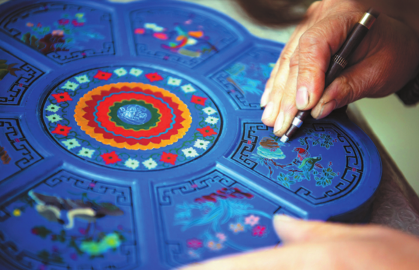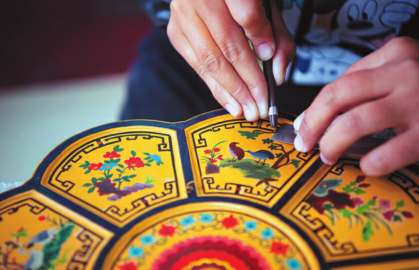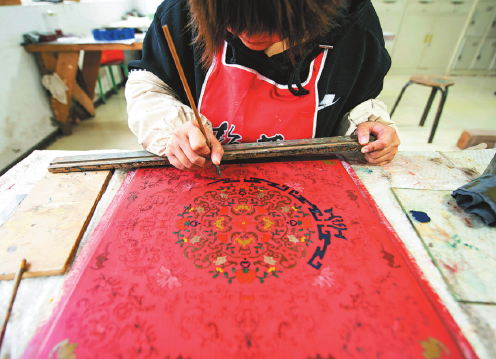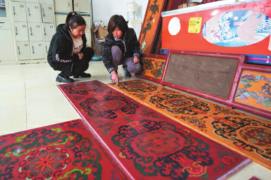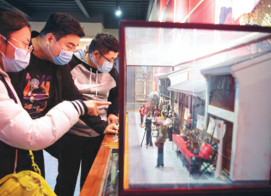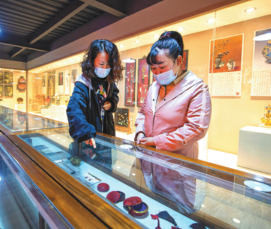Traditional crafts shape future
Revival of time-honored skills boosts village income and tourist flow, Yang Feiyue and Zhang Yu report.

Everything is glimpsed through the prism of history when one sets foot in Nanhan village. An antique tablet first greets one's eye at the entrance to the village that is a 30-minute drive from downtown Langfang, North China's Hebei province.
As one explores the village further, rows of ancient buildings, walls, carved doorways, and wooden and stone pagodas of similar styles spring into view.
They all emanate a strong vibe of traditional culture and crafts and bring people back in time.
Zhou Hongjun created a beguiling piece of work at his workshop in the village in early December.
Delicate items ranging from jewelry boxes and ornaments to decorative screens made of red sandalwood took up most space in his work studio.
Zhou has benefited from the village's support for traditional craft preservation and development over the years.
He entered the Nanhan jade-grinding plant in 1982 and got to hone his skills of the craft under the tutelage of Zhou Qingyuan, a master artisan from the Beijing Gold Lacquer Inlaid Co, who was invited by the village authorities.
"He was very strict with me, and I learned all the techniques under his tutorship," Zhou Hongjun says.
The 57-year-old has worked his way up to be a provincial inheritor of the hundred-treasure inlay craftsmanship that originated in the Ming Dynasty (1368-1644) and features gems, ivory, coral, jade and other precious materials being selectively embedded to highlight a specific theme and enhance decorative effect.
The lacquerware of hundred-treasure inlays includes folding screens, table plaques and benches. The change of the angles of the rebounding light casts various shades of luster on the patterns of hundred-treasure inlays, conjuring up a rainbow of colors and displaying an air of nobility and magnificence.
The inlay technique requires complex steps and was on the verge of disappearing as few people had the required skills.
"I was encouraged to commit myself to the craft when it was named a provincial intangible cultural heritage in 2017," Zhou Hongjun says.
He has given all his energy to the inheritance and preservation of the craft in recent years. He has so far produced and repaired more than 1,500 inlaid artworks.
The technique has been widely applied to Chinese classical furniture and products of arts and crafts by intangible cultural heritage inheritors, including Zhou Hongjun, who are engaging in classic art creations in Nanhan village.
Birth of craftsmanship
The village boasts a long history and its residents used to make their way to the colorful glaze factory in Beijing and served the royal family during the Ming Dynasty, says Gou Shuren, the village's Party secretary.
Although there has been back and forth in the village development, the villagers' craftsmanship has managed to survive the test of time and get carried forward, Gou says.
Craftsmanship in the village got an opportunity to evolve when a local named Gou Lingzhi was appointed a magistrate in Tongzhou, Beijing, on the strength of his knowledge and writing during the reign of Emperor Daoguang of the Qing Dynasty (1644-1911). He continued to make his way to the imperial palace and became a teacher of the royal children.
Under his recommendation, the carpenters from Nanhan village were then admitted to workshops in the palace, making furniture and other daily items for the royal family.
"Therefore, they got to know many other craftsmen in the palace and hone their skills, planting the seeds of development of Nanhan village afterward," Gou Shuren says.
In 1973, a foreign trade company sent several senior craftsmen to Nanhan and set up the Nanhan jade-grinding plant, which evolved to produce a wide range of artifacts, such as Ming-style chairs, Qing-style red sandalwood tables, jade-inlaid jewelry and seal boxes.
The elegant design and fine workmanship immediately made Nanhan's works popular across the country.
Yet, the plant bore the brunt of changes in the country's economic and market development in the 1980s, and broke up. The workers then went on their own and were struggling to find odd jobs to make ends meet, some even having to leave home.
Things took a turn for the better in 2015 when the village authorities brought together those scattered artisans and established the Nanhan mahogany furniture and tourism products association.
The association then standardized quality management and marketing operations, and sent Party members to broaden sales channels.
The improved business-running model and the exquisite craftsmanship of the products soon saw the annual income of Nanhan village reach more than 130 million yuan ($18.92 million), with per capita income of more than 100,000 yuan.
The products have been widely recognized by overseas markets and have made their way to the United States, the United Kingdom and South Korea.
Those improved conditions have also helped preserve and carry forward the historical craftsmanship, ranging from wood, jade and lacquer carving and filling, gilding and painting.
"Locals have come to believe that possessing a handicraft skill can enable them to make a living," Gou Shuren says.
To date, more than 1,700 locals have been involved in traditional crafts business, and more than 200 people have acquired multiple skills.
It has been a routine for Gou Jianhui to engrave the outlines of such items as jewelry boxes.
"The handicraft should be practical and embody people's attitude toward life," the 53-year-old says.
He learned the techniques of carved lacquerware, a provincial intangible cultural heritage, from master artisans.
"The Party and the government have done a lot for us, which has consolidated our confidence," Gou Jianhui says.
"Therefore, the palatial crafts should not end in our hands," he adds.
Gou Jianhui has been exploring the application of traditional crafts to modern life.
"The idea is to have people see them, feel them and be able to afford them," he says.
Young inheritors
Liu Junchao is one of the youngest artisans in the village.
"Basically children going to the village's primary schools have been exposed to local culture by the faculty members," the 33-year-old says.
Liu started to learn about lacquering craft at a workshop in the village after graduation from a vocational school in 2005.
He is now preparing to build a public cultural and creative education center to provide free training for young people who are interested in learning handicrafts, and will also use short-video platforms to release free teaching videos.
To date, the village has been home to 72 enterprises that mainly engage in the production of lacquer furniture in the classic style, with traditional crafts, of which 23 are intangible cultural heritages at the provincial, city and district levels.
The output value reached more than 300 million yuan in 2020, according to village authorities.
The village has stepped up support for local artisans, whose products were sent to various events to get more publicity exposure and compete for awards. Vocational training for villagers has been carried out, so more people can become inheritors and practitioners of local craftsmanship.
An unexpected windfall has come in recent years as more travelers started to visit Nanhan village to savor the permeating ancient palatial culture. It has boosted local tourism and resulted in more income to the villagers.
"Nanhan village will actively build a tourism industry led by antique furniture, palace products and fruit-picking," says Wan Wei, an official in Nanhan village.
The village will integrate local manufacturing with culture and tourism to spice up traveler experience.
"The idea is to carve out a new road of beautiful countryside that is ideal for living, working and traveling," Wan says.
